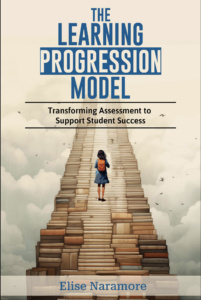- Elise
- August 12, 2024
- Assessment, Growth, Reflective Practice, Teaching
The Learning Progression Model: Transforming Assessment to Support Student Success
For those of you new to this blog, I’m Elise Naramore, a high school physics teacher in northern New Jersey, with over three decades of teaching experience. Throughout my career, I’ve tried many teaching strategies, but the conversation with my students never shifted from “How do I get an A?” to “How do I learn how to do this?” My goal has always been for my students to leave with skills and knowledge that will be useful to them in the future. I couldn’t achieve that when all they cared about was getting through the class and earning an A.
What is the Learning Progression Model?
I have a deep passion for education, and that passion led me to develop an innovative assessment approach called the Learning Progression Model. This is not a theoretical construct, but something I use everyday in my classes. You might be wary of trying this out because educators are constantly bombarded with new fads and trends. But this is neither a trend nor a fad. With the learning progression model, you don’t have to change your curriculum, worksheets, tests, or projects. What changes is how you provide feedback and report progress.
Using learning progressions, I now have a flexible system that can be used for any level of class, tailored to my curriculum, and easily adaptable and differentiable. If I can’t support the individual needs of my students—if the gifted students are bored and the struggling students are lost—am I really being an effective teacher? The learning progression model enables me to engage all learners, from those who are striving to those who are gifted and may become distracted if not challenged.
I wrote a book!
So, I wrote a book to share this information with you. For those of you who have read Going Gradeless, published in 2021, and have read my blog posts, you will love this book. This is not merely an updated version of Going Gradeless but an expansion of it. Filled with sample learning progressions and student work, you will find plenty of relevance, no matter what you teach.

A Roadmap for Teachers
I wrote this book to provide a roadmap for teachers who want to support all students in learning and growing. It doesn’t matter what you teach—whether it’s math, science, English Language Arts, world languages, or anything else—you can use the learning progression model. This model offers a more flexible and developmentally appropriate path for students to follow during the school year they spend with you.
How the book is organized
The first part of this book provides some background on why this approach is important. Why make the change? Teaching is hard work, and it’s tempting to stick with traditional grading methods because that’s how we were taught, and it’s what we’ve always used. But we have to ask ourselves why we keep doing something when we’re pretty sure it doesn’t work. What makes the LPM different from traditional grading or standards-based assessment?
This is an evidence-based system and rests on solid pedagogy. The next section of the book, we investigate the research-based background of the learning progression method, offering the evidence you need to understand why this approach is valid and effective. You will need to understand the theories undergirding the approach so that you will be able to explain it to your students, their parents, and your administrators.
The central part of the book walks you through the essential components of this method: developing your learning progressions, identifying the skills and practices to break down into developmental stages, deciding on assessments, and reorganizing practice. It also covers how to adjust the feedback you give, although this might not change drastically. We’ll discuss target levels and how to use them effectively.
Following this, we’ll explore how to report and record student progress and how to engage students in this process. The final part of the book looks to the future, addressing the challenges we still face and discussing how to scale this approach across schools or districts.
Throughout the book, you’ll find hundreds of figures, tables, case studies, and examples to help you see how this method is implemented and to support you in designing your own approach. There are also three appendices with numerous examples from various fields to further assist you.

Flexible and Useful
In my opinion, the best part of LPM is how it provides a flexible and systemized framework to guide students through the development of specific skills. This framework can be used across all content areas and course levels. My greatest hope is to create a community of like-minded people, working to shift the inertia in the American public school system. I hope that this book will be a resource that you can use towards that end.
The book is now available on Amazon in paperback, hardcover, or ebook. The audiobook will be published in late September 2024. Please leave a rating and review, and forward this post to other educators! Help me reach as many people as possible.
If you have any questions, reach out to me through the contact page above or at [email protected].


